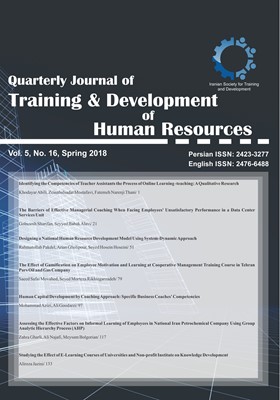Recognition of the Performance Gap Model in Iran's Social Security Organization in order to Approach Shift in Conventional Training
Subject Areas :Mohammad salehi 1 , Shervin Mashayekhi 2 , Taraneh Enayati 3
1 -
2 -
3 -
Keywords: Performance, performance gaps, Human performance improvement, Intervention, Training.,
Abstract :
The purpose of this study was to identify the dimensions and components of the performance gap in the social security organization. The main method of this study was survey method. Data collection by questionnaire and the analysis is done with the help of PLS software. The statistical population of the study includes all employees of different levels of social security organization that 395 of them were selected randomly as the sample. Data collected through exploratory factor analysis were analyzed and then finalized the reliance on the confirmatory factor analysis; The research findings indicate that the "performance gap" can be explained in three dimensions: leadership style, work environment, and manpower management; Based on the findings in the first dimension, the components of the "strategic approach", "interactive and transparent work environment", " "style of authority" and "feedback from stakeholders", the components of second dimension are, "performance management", "recruitment and appointment system", "the effectiveness of job incentive tools", "effective training", "compensation system" and "specialized knowledge , and Finally, the components of the third dimension are, "moral and informational discipline", "participatory culture" and "knowledge-based" were confirmed. In this way, while developing the final model of the performance gap in the Social Security Organization, and the provided model had a good fit in terms of the experts' perspective with a strong 0.6 value.
1. Talbot C. Theories of performance: Organizational and Service Improvement in the Public Domain. 2010. Oxford: Oxford University Press.
2. Enos D. Performance Improvement: making it happen. 2007. New York: Taylor & Francis Group.
3. Addison R M, Haig C. The Performance Architect’s Essential Guide to the Performance Technology Landscape. 2006. In J. A. Pershing (Ed.). Handbook of human performance technology: principles, practices and potential (3rd ed.). (pp. 35-54). San Francisco, Pfeiffer.
4. Gilmore E R, Pershing J A. Don’t miss! Identify all causes of that performance gap: A review of literature supporting a refinement of Wile’s HPT model. 2001. The annual meeting of the International Society for Performance Improvement, San Francisco.
5. While D. Why Doers Do. Performance and Instruction, 1996; 35 (1): 30-35.
6. Pershing J. Handbook of human performance technology: principles, practices and potential (3rd ed.). 2006. San Francisco: Pfeiffer.
7. Rossett A. Analysis and More. 2006. In J. Pershing (Ed.). Handbook of Human Performance Technology: Principles, Practices and Potential (3rd ed.) (pp. 208-222). San Francisco, Pfeiffer.
8. Khoshmashraban Z. Designing the implementation of a human performance technology (Hpt) model: A study in Sina Bank. Master's Degree, Tehran University, 2013.
9. Ferond C. The origins and evolution of human performance technology. 2006. In J. A. Pershing (Ed.), Handbook of human performance technology: principles, practices and potential (3rd ed.). (pp. 155-187). San Francisco, Pfeiffer.
10. Sabbaghian Z, Akbari S. A Comprehensive Training in Organizations (with Adult Education Approach). 2th ed. 2015. Tehran: Samt Publication.
11. Rothwell, William. Beyond Training and Development: The Groundbreaking Classic on Human Performance Enhancement. 2005. New York: American Management Association.
12. Khorasani A, Vafaeezadeh M. Human Performance Technology: Basics and principles. 2016. Tehran: Ostadan Publication.
13. Picolo J, Machado D, Tontini G, Dockhorn M, Gava S. Using Improvement Gap Analysis for the management of trade-offs of operational strategies. Gest. Prod. 2016; 23(1): 48-59.
14. Fasset . Gap Analysis Report. 2002. Gauteng: Management Consulting Learnership Project.
15. AHRQ. Gap Analysis. Pediatric Toolkit for Using the AHRQ Quality Indicators. 2018. Rockville: Agency for Healthcare Research and Quality
16. Russell-Brown P. Gap Analysis; Final Report. 2016. Kingston: Ministry of Health.
17. Center for Public Health Leadership. Gap Analysis. 2014. Harvard: School of Public Health.
18. UCLA Health. Course Planning Tip Sheet: Gap Analysis. 2016. Los Angeles: UCLA Nursing.
19. WHO. Gap Analysis. Pandemic Influenza Preparedness Framework Partnership Contribution. 2013. Geneva: World Health Organization.
20. Currie, Graham. Gap Analysis of Public Transport Needs: Measuring Spatial Distribution of Public Transport Needs and Identifying Gaps in the Quality of Public Transport Provision. Journal of the Transportation Research Board, 2004. 1895 (1): 137-146.
21. PCG Education. Data Gap Analysis. 2010. Washington: Public Consulting Group.
22. Murray J. The Gap Analysis Process to Improve IT Management. 2000. Florida: CRC Press
23. Mohammadi Sabet M, Fayyazi B, Shah Hoseini M. Designing a model for human performance technology: A study in SAPCO. Iranian journal of management sciences. 2016; 42 (11): 99-124.
24. Rezaee M. Review the gap between the existing and desirable performance of the Balanced Scorecard system: A study in National Iranian Copper Industries Co (nicico). International Conference on Economic Management Accounting and Social science. 2014 May 31. Rasht Iran.
25. Faghihi A, Alizadeh M. Validity in qualitative research. Journal of Organizational Culture Management. 2005; 2 (3): 5-19.


